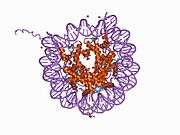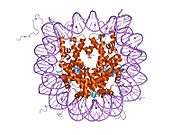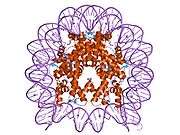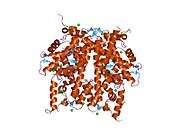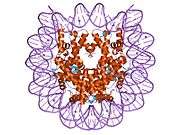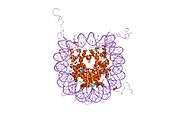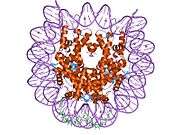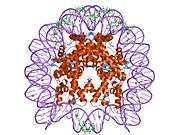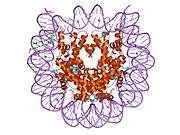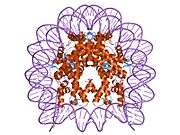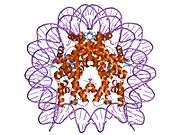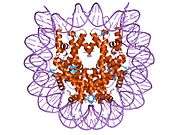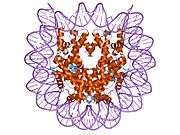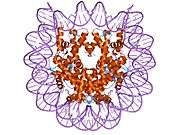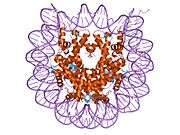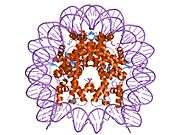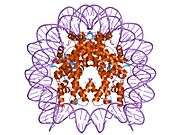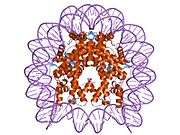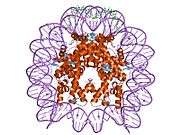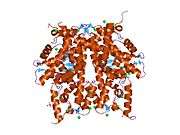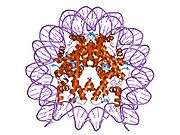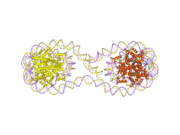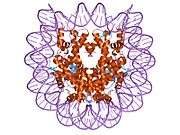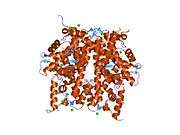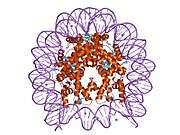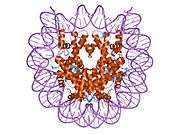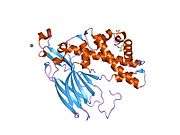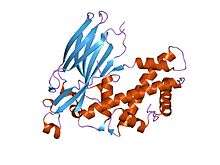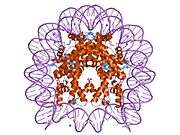H3F3A
Histone H3.3 is a protein that in humans is encoded by the H3F3A gene.[5]
Histones are basic nuclear proteins that are responsible for the nucleosome structure of the chromosomal fiber in eukaryotes. Two molecules of each of the four core histones (H2A, H2B, H3, and H4) form an octamer, around which approximately 146 bp of DNA is wrapped in repeating units, called nucleosomes. The linker histone, H1, interacts with linker DNA between nucleosomes and functions in the compaction of chromatin into higher order structures. This gene contains introns and its mRNA is polyadenylated, unlike most histone genes. The protein encoded is a replication-independent member of the histone H3 family.[6]
Mutation of H3F3A are also linked to certain cancers. p.Lys27Met were discovered in Diffuse Intrinsic Pontine Glioma (DIPG),[7] where they are present 65-75% of tumors and confer a worse prognosis.[8] p.Lys27Met alterations in HIST1H3B and HIST1H3C, which code for histone H3.1 have also been reported in ~10% of DIPG.[9] H3F3A is also mutated in a smaller portion of pediatric and young adult high grade astrocytomas but more frequently as p.Gly34Arg/Val. Mutations in H3F3A and H3F3B are also found in chondroblastoma and giant cell tumor of bone.[10]
References
- 1 2 3 GRCh38: Ensembl release 89: ENSG00000163041 - Ensembl, May 2017
- 1 2 3 GRCm38: Ensembl release 89: ENSMUSG00000060743 - Ensembl, May 2017
- ↑ "Human PubMed Reference:".
- ↑ "Mouse PubMed Reference:".
- ↑ Wells D, Hoffman D, Kedes L (May 1987). "Unusual structure, evolutionary conservation of non-coding sequences and numerous pseudogenes characterize the human H3.3 histone multigene family". Nucleic Acids Res. 15 (7): 2871–89. doi:10.1093/nar/15.7.2871. PMC 340704. PMID 3031613.
- ↑ "Entrez Gene: H3F3A H3 histone, family 3A".
- ↑ Wu G, Broniscer A, McEachron TA, et al. (Jan 2012). "Somatic histone H3 alterations in pediatric diffuse intrinsic pontine gliomas and non-brainstem glioblastomas". Nat Genet. 44 (3): 251–3. doi:10.1038/ng.1102. PMC 3288377. PMID 22286216.
- ↑ Khuong-Quang DA, Buczkowicz P, Rakopoulos P, et al. (Sep 2012). "K27M mutation in histone H3.3 defines clinically and biologically distinct subgroups of pediatric diffuse intrinsic pontine gliomas". Acta Neuropathol. 124 (3): 439–47. doi:10.1007/s00401-012-0998-0. PMC 3422615. PMID 22661320.
- ↑ Buczkowicz P, Hoeman C, Rakopoulos P, Pajovic S, Letourneau L, Dzamba M, et al. (May 2014). "Genomic analysis of diffuse intrinsic pontine gliomas identifies three molecular subgroups and recurrent activating ACVR1 mutations". Nature Genetics. 46 (5): 451–6. doi:10.1038/ng.2936. PMC 3997489. PMID 24705254.
- ↑ Behjati S, Tarpey PS, Presneau N, et al. (Dec 2013). "Distinct H3F3A and H3F3B driver mutations define chondroblastoma and giant cell tumor of bone". Nat Genet. 45 (12): 1479–82. doi:10.1038/ng.2814. PMC 3839851. PMID 24162739.
Further reading
- Zhang Y, Reinberg D (2001). "Transcription regulation by histone methylation: interplay between different covalent modifications of the core histone tails". Genes Dev. 15 (18): 2343–60. doi:10.1101/gad.927301. PMID 11562345.
- Wells D, Kedes L (1985). "Structure of a human histone cDNA: evidence that basally expressed histone genes have intervening sequences and encode polyadenylylated mRNAs". Proc. Natl. Acad. Sci. U.S.A. 82 (9): 2834–8. doi:10.1073/pnas.82.9.2834. PMC 397660. PMID 2859593.
- Ohe Y, Iwai K (1982). "Human spleen histone H3. Isolation and amino acid sequence". J. Biochem. 90 (4): 1205–11. PMID 7309716.
- Kato S, Sekine S, Oh SW, et al. (1995). "Construction of a human full-length cDNA bank". Gene. 150 (2): 243–50. doi:10.1016/0378-1119(94)90433-2. PMID 7821789.
- Albig W, Bramlage B, Gruber K, et al. (1996). "The human replacement histone H3.3B gene (H3F3B)". Genomics. 30 (2): 264–72. doi:10.1006/geno.1995.9878. PMID 8586426.
- Palaparti A, Baratz A, Stifani S (1997). "The Groucho/transducin-like enhancer of split transcriptional repressors interact with the genetically defined amino-terminal silencing domain of histone H3". J. Biol. Chem. 272 (42): 26604–10. doi:10.1074/jbc.272.42.26604. PMID 9334241.
- Lin X, Wells DE (1998). "Localization of the human H3F3A histone gene to 1q41, outside of the normal histone gene clusters". Genomics. 46 (3): 526–8. doi:10.1006/geno.1997.5037. PMID 9441765.
- El Kharroubi A, Piras G, Zensen R, Martin MA (1998). "Transcriptional Activation of the Integrated Chromatin-Associated Human Immunodeficiency Virus Type 1 Promoter". Mol. Cell. Biol. 18 (5): 2535–44. doi:10.1128/mcb.18.5.2535. PMC 110633. PMID 9566873.
- Goto H, Tomono Y, Ajiro K, et al. (1999). "Identification of a novel phosphorylation site on histone H3 coupled with mitotic chromosome condensation". J. Biol. Chem. 274 (36): 25543–9. doi:10.1074/jbc.274.36.25543. PMID 10464286.
- Lo WS, Trievel RC, Rojas JR, et al. (2000). "Phosphorylation of serine 10 in histone H3 is functionally linked in vitro and in vivo to Gcn5-mediated acetylation at lysine 14". Mol. Cell. 5 (6): 917–26. doi:10.1016/S1097-2765(00)80257-9. PMID 10911986.
- Deng L, de la Fuente C, Fu P, et al. (2001). "Acetylation of HIV-1 Tat by CBP/P300 increases transcription of integrated HIV-1 genome and enhances binding to core histones". Virology. 277 (2): 278–95. doi:10.1006/viro.2000.0593. PMID 11080476.
- Lachner M, O'Carroll D, Rea S, et al. (2001). "Methylation of histone H3 lysine 9 creates a binding site for HP1 proteins". Nature. 410 (6824): 116–20. doi:10.1038/35065132. PMID 11242053.
- Zhong S, Zhang Y, Jansen C, et al. (2001). "MAP kinases mediate UVB-induced phosphorylation of histone H3 at serine 28". J. Biol. Chem. 276 (16): 12932–7. doi:10.1074/jbc.M010931200. PMID 11278789.
- Suzuki H, Fukunishi Y, Kagawa I, et al. (2001). "Protein–Protein Interaction Panel Using Mouse Full-Length cDNAs". Genome Res. 11 (10): 1758–65. doi:10.1101/gr.180101. PMC 311163. PMID 11591653.
- Deng L, Wang D, de la Fuente C, et al. (2001). "Enhancement of the p300 HAT activity by HIV-1 Tat on chromatin DNA". Virology. 289 (2): 312–26. doi:10.1006/viro.2001.1129. PMID 11689053.
- Bauer UM, Daujat S, Nielsen SJ, et al. (2002). "Methylation at arginine 17 of histone H3 is linked to gene activation". EMBO Rep. 3 (1): 39–44. doi:10.1093/embo-reports/kvf013. PMC 1083932. PMID 11751582.
- Zegerman P, Canas B, Pappin D, Kouzarides T (2002). "Histone H3 lysine 4 methylation disrupts binding of nucleosome remodeling and deacetylase (NuRD) repressor complex". J. Biol. Chem. 277 (14): 11621–4. doi:10.1074/jbc.C200045200. PMID 11850414.
- Goto H, Yasui Y, Nigg EA, Inagaki M (2002). "Aurora-B phosphorylates Histone H3 at serine28 with regard to the mitotic chromosome condensation". Genes Cells. 7 (1): 11–7. doi:10.1046/j.1356-9597.2001.00498.x. PMID 11856369.





